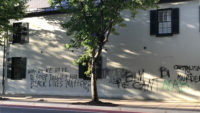Designers Quantify Racial Injustice in Data-Driven Installation on National Mall

Society's Cage will be installed on the National Mall through September 12, 2020. Photo: Alan Karchmer Photography, courtesy SmithGroup
Architects & Firms
Editor's Note: This installation has been extended through September 12, 2020.
On August 28, 2020, an estimated 50,000 people will join together for a March on Washington on the 57th anniversary of the famous march that culminated in Dr. Martin Luther King, Jr.’s “I Have a Dream” speech, delivered from the Lincoln Memorial.

Those gathering this year will hear Reverend Al Sharpton deliver an address tentatively titled “Get Your Knee Off Our Necks,” tying this pivotal uprising to the May 2020 killing of George Floyd by Minneapolis police, when one officer, Derek Chauvin, fatally knelt upon Floyd’s neck for 8 minutes and 46 seconds. While Floyd’s death has been the catalyst for the current social upheaval, it’s hardly the only example of police violence toward Black Americans; two months prior, Breonna Taylor was shot to death in her own home in Kentucky while she slept, and just this week, Jacob Blake was shot in the back seven times by police in Wisconsin, where he remains in critical condition.
Just a short ways down the National Mall from the Lincoln Memorial, designers from the local office of SmithGroup—mostly people of color—are installing an intimate platform for grappling with racial injustice, called Society’s Cage. Measuring roughly 14 feet square, the temporary pavilion formed by a forest of vertical bars serves as an interpretive space as well as a contemplative one. Its exterior educates visitors on systemic racism through data on lynching, capital punishment, police brutality, and mass incarceration, while its interior offers a place for solemn reflection.

Architecture is a profession in which Black people have historically been underrepresented, but in this national moment of reckoning, Black architects have been making their voices heard in solidarity with the Black Lives Matter movement. “This was a grassroots effort,” says Dayton Schroeter, who is a principal architect in SmithGroup’s DC office and one of the lead designers of the project, alongside Julian Arrington. “It was born of a diverse group of architects at SmithGroup who really wanted to do something in the aftermath of the George Floyd and Breonna Taylor murders. We wanted to contribute to the discussions happening in our society, and within our profession, as we all reckon with the legacy of institutional racism and white supremacy.”
That legacy is reflected in the structure’s physical presence: starting from the Platonic ideal of a cube, vertical steel pipes—a reference to the metaphoric cage—are suspended from the ceiling. The walls form literal bar graphs of data, each conveying statistics on civilian death by police, capital punishment, mass incarceration, and lynching. These bars are carved away to produce an inhabitable void, with the undulating curvature of its top dictated by the convergence of data points. “The form and shape of the pavilion is a physical representation of racist institutional structures that have acted historically to compromise true equality and fairness in our society,” Schroeter explains. “The void is the symbolic representation of the systemic forces that devalue and compromise Black life.”

Yet it’s within that void—where visitors are immersed in an 8-minute, 46-second soundscape commissioned for the project—that, as co-designer Arrington puts it, one finds opportunity to reflect on not just the recent tragedies, but the more than 400 years of history preceding them. “These events are part of a continuum, and this design is really an expression of that,” he says. “It forces people to acknowledge that that these things exist, whether it's the murders or things of the past. And our effort is really about putting this out there and getting people to acknowledge it so that we can have that moment of reflection.”
The design’s overt references to spaces of confinement bring up another point of contention within the profession: In June, Michael Ford, who founded Hip Hop Architecture, resigned from SmithGroup after learning that the firm was involved in a master plan for a Wisconsin civic project that included extant holding facilities. The firm has since released a statement saying that it does not work with facilities for mass incarceration, and that it is committed to asking critical questions and getting uncomfortable. “If the conversation now isn’t uncomfortable, it isn’t going to be impactful. That’s what’s made racism so ingrained,” says Troy Thompson, a managing partner with the firm. “For the last couple generations of leadership, we’ve had an unspoken rule that we won’t do facilities of mass incarceration. But it was never spoken. The situation now has led us to say it in public.”

Difficult conversations at the outset of this project have guided the designers through their process. “This was a process-driven design, where the resulting aesthetic was driven by data,” Schroeter says. “And data was driven by questions: What is the value of Black lives? What’s the relationship to Black people to the power structures of this country? The resulting architectural and sculptural form is social and political in nature, because the questions we asked were social and political in nature.”
The installation Society’s Cage will be on view on the National Mall, at 12th Street and Madison Drive NW, August 28–September 12.





